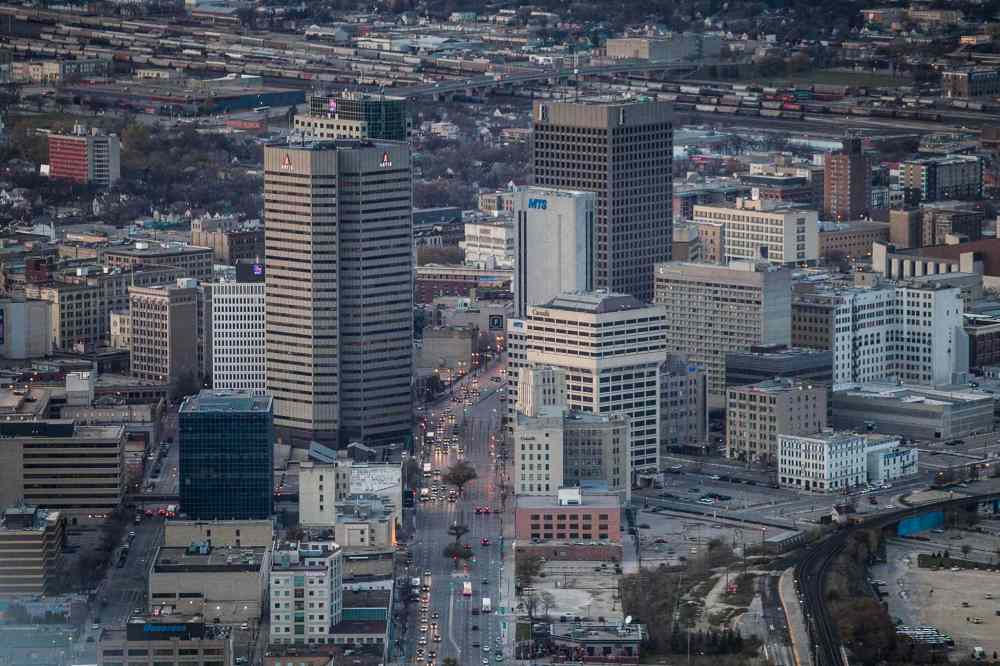Without revitalization, Portage and Main could lose out to True North Square
Advertisement
Read this article for free:
or
Already have an account? Log in here »
To continue reading, please subscribe:
Monthly Digital Subscription
$0 for the first 4 weeks*
- Enjoy unlimited reading on winnipegfreepress.com
- Read the E-Edition, our digital replica newspaper
- Access News Break, our award-winning app
- Play interactive puzzles
*No charge for 4 weeks then price increases to the regular rate of $19.00 plus GST every four weeks. Offer available to new and qualified returning subscribers only. Cancel any time.
Monthly Digital Subscription
$4.75/week*
- Enjoy unlimited reading on winnipegfreepress.com
- Read the E-Edition, our digital replica newspaper
- Access News Break, our award-winning app
- Play interactive puzzles
*Billed as $19 plus GST every four weeks. Cancel any time.
To continue reading, please subscribe:
Add Free Press access to your Brandon Sun subscription for only an additional
$1 for the first 4 weeks*
*Your next subscription payment will increase by $1.00 and you will be charged $16.99 plus GST for four weeks. After four weeks, your payment will increase to $23.99 plus GST every four weeks.
Read unlimited articles for free today:
or
Already have an account? Log in here »
Hey there, time traveller!
This article was published 03/02/2016 (3569 days ago), so information in it may no longer be current.
If you’re 37 years old or less, you can’t remember a time when you could cross Portage and Main on foot without breaking a rule and acting out a game of Frogger.
Winnipeg’s most famous intersection was closed to pedestrians on Feb. 24, 1979, the same day then-mayor Robert Steen opened an underground concourse originally dubbed the Portage and Main Circus.
While pretty much nobody uses that name today, the closure of Portage and Main really did turn out to be a circus. The closure didn’t spark much controversy at the time, but subsequent changes in public opinion have caused all kinds of headaches for the City of Winnipeg as well as property owners surrounding the intersection.

In the 1990s, former mayor Susan Thompson pledged to reopen the intersection before the start of the Pan Am Games. That goal turned out to be just as improbable as the construction of a laser pyramid.
Thompson’s even more idealistic successor, Glen Murray, proposed a $20-million transformation of the intersection into a Times Square-like plaza. Murray also launched a design contest to figure out the best way to reopen Portage and Main.
The winning design was the “Light Forest” concept envisioned by Winnipeg’s Corbett Cibinel Architects and Toronto’s Janet Rosenberg and Associates.
It called for wind turbines on Portage Avenue East, two canoe-shaped glass entranceways to the circular underground concourse, green paving stones that resemble vegetation and nine-metre illuminated poles that resemble trees.
The problem was, the concept emerged in 2005, after the mercurial Murray had resigned as mayor and his replacement, Sam Katz, had his own ideas about urban revitalization.
In 2007, when a fleshed-out “Light Forest” concept finally came to council – along with a plan to reopen Portage and Main on evenings and weekends – Katz wanted no part of the proposal, which came with a $10.5-million pricetag as well as the need to convince all seven Portage and Main property owners to reopen a deal to keep the intersection closed to pedestrians.
This brings us to today, when another swing of the Portage and Main pendulum has Mayor Brian Bowman vowing to reopen the intersection – and the deal to close it set to expire in 2017.
At the political level, there isn’t much opposition to opening the intersection. The bigger task, which the city appears to understand, will be selling the public on the benefits of such a move.
While urbanist-minded Winnipeggers understand the notion that pedestrian activity is a crucial component of a safe and vibrant downtown, there are motorists who will never abide by anything that slows them down.
That said, the intersection wasn’t closed in ’79 to speed up traffic. Rather, it was done to assure a steady flow of pedestrians into the underground mall now known as Winnipeg Square, as well as the shops below Richardson Centre.
This is a big reason the owner of what’s now 360 Main St. and Winnipeg Square has been the most adamant opponent to reopening Portage and Main. In 2007, when the city half-heartedly considered pedestrian crossings on evenings and weekends, the owner of the office tower and mall was singled out by the city as the largest holdout.
At the time, that was Oxford Properties. Today, the mall and tower are owned by Artis REIT, which remains a crucial player in any plan to reopen Portage and Main.
Even with the looming expiration of the legal deal to close the intersection, the city still needs the support of the adjacent property owners to make a remodelled intersection work, with or without a facelift that would transform it into a public plaza.
That’s because it would take millions to make substantive changes and the cash-strapped city desperately needs private partners in a project of this scale. The bigger the corporate buy-in, the better the project.
One reason Portage and Main property owners may be reluctant to invest is recent government support for a different section of downtown: south of Portage Avenue, where True North Sports and Entertainment plans to create a public gathering space of its own.
A firm like Artis may wonder why the heck it should spend money to improve Portage and Main when future city and provincial tax dollars are devoted to True North Square.
This would be short-sighted. However successful a south-of-Portage project turns out to be, it lacks the history and importance already imbued in Portage and Main.
If Portage and Main property owners miss an opportunity to revitalize the city’s most famous intersection, they run the risk of losing their prime position to a pair of empty surface-parking lots abutting Carlton Street.
bartley.kives@freepress.mb.ca




